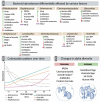A systematic review of the factors influencing microbial colonization of the preterm infant gut
- PMID: 33818293
- PMCID: PMC8023245
- DOI: 10.1080/19490976.2021.1884514
A systematic review of the factors influencing microbial colonization of the preterm infant gut
Abstract
Prematurity coupled with the necessary clinical management of preterm (PT) infants introduces multiple factors that can interfere with microbial colonization. This study aimed to review the perinatal, physiological, pharmacological, dietary, and environmental factors associated with gut microbiota of PT infants. A total of 587 articles were retrieved from a search of multiple databases. Sixty studies were included in the review after removing duplicates and articles that did not meet the inclusion criteria. Review of this literature revealed that evidence converged on the effect of postnatal age, mode of delivery, use of antibiotics, and consumption of human milk in the composition of gut microbiota of PT infants. Less evidence was found for associations with race, sex, use of different fortifiers, macronutrients, and other medications. Future studies with rich metadata are needed to further explore the impact of the PT exposome on the development of the microbiota in this high-risk population.
Keywords: Preterm infant; antibiotics; dysbiosis; gut colonization; gut microbiota; human milk; mode of delivery.
Figures
References
-
- Hasan N, Yang H.. Factors affecting the composition of the gut microbiota, and its modulation. PeerJ [Internet]. 2019;7:e7502. https://pubmed.ncbi.nlm.nih.gov/31440436 - PMC - PubMed
-
- Deschasaux M, Bouter KE, Prodan A, Levin E, Groen AK, Herrema H, Tremaroli V, Bakker GJ, Attaye I, Pinto-Sietsma S-J, et al. Depicting the composition of gut microbiota in a population with varied ethnic origins but shared geography. Nat Med [Internet]. 2018;24(10):1526–33. doi:10.1038/s41591-018-0160-1. - DOI - PubMed
Publication types
MeSH terms
Substances
Grants and funding
LinkOut - more resources
Full Text Sources
Other Literature Sources
Medical


